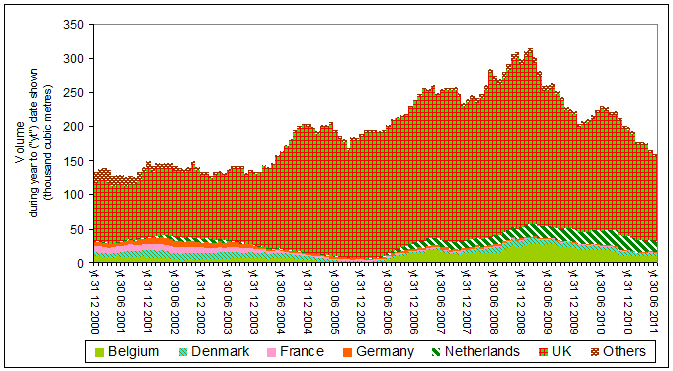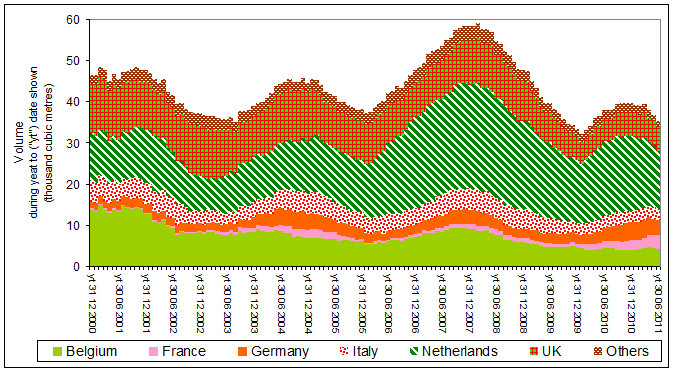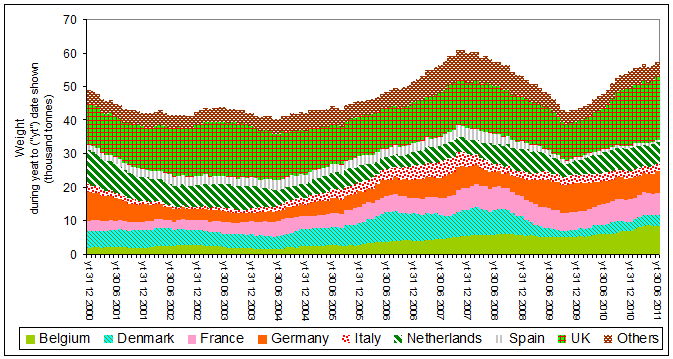|
|
||
|
Malaysia Click here for additional briefing UNDER CONSTRUCTION EU imports from Malaysia: General considerations Species Sawn wood Plywood Mouldings Joinery Wooden furniture Other products Due diligence should focus not on sub-national region (Sarawak, Sabah and Peninsular Malaysia) but also the concession from which the timber derives. The management of all permanent reserved forest in Peninsular Malaysia is certified as complying with a scheme - the Malaysia Timber Certification Scheme - which is deemed to indicate legality by the UK government[*] and which is endorsed by the PEFC, although there have been some criticism[p5]. However, very little of this is exported with a chain of custody.[p5] The great majority of Peninsula Malaysia's timber exports derive from such forest. Operators should demand a chain of custody for all the timber in consignments which they purchase in order to minimise the risk that these are contaminated by illegal timber. The quantity of illegal timber entering Peninsular Malaysia and its free zones is likely to be smaller than it was a decade ago[slides 10 & 11][p25][p7-p14], although a member of parliament has been linked to such imports[*] and there are occasional reports of illegal logging, including in protected areas. The legal status of timber logged elsewhere in Peninsular Malaysia is likely to be be more difficult to assess, particularly if the ruling party has an interest[footnote 8 p543]. 2) - Species: Sarawak (and Indonesia) restricts the export of products made from a number of tree species, notably ulin Eusideroxylon zwageri[*]. Despite Malaysian resistance[¶1 p2], Ramin Gonystylus spp. is listed in CITES. The IUCN Red List[*] suggests that the conservation status of most species of trees from which Malaysia's exports of tropical timber derive is either vulnerable or more serverely threatened with extinction - notably several species of Shorea, including most forms of dark red meranti (other than Shorea curtisii) (which account for most tropical timber production in Peniunsular Malaysia[*], Sarawak [Table 2.2], and presumably Sabah) and some forms of selangan batu / bangkirai / yellow balau[*] (other than Shorea laevis). Their conservation status is similar to that of those species of Dipterocarpus (which includes keruing), Palaquium (which includes nyatoh), Dryobalanops (which includes kapur) and Anisoptera (which includes mersawa) which grow in Malaysia. Other species, such as Koompassia (which includes kempas) and Dyera (which includes jelutong) appear to be less vulnerable. The status of tropical timber species is likely to have deteriorated since their entries in IUCN Red List were last revised (during the 1990s). 3) - Products:
Peninsular Malaysia accounted for approximately three quarters of the total during 2009. Sabah accounted for almost all the rest from Sabah. At least some of the former will have been supplied from FSC-certified forest with a chain of custody.
Repeated exposés of illegality and unsustainability in Sarawak's timber sector have obliged a number of importers in the EU to cease importing plywood from Sarawak.[p30] Almost all the plywood exported from Malaysia during 2009 was supplied from Peninsular Malaysia.
Roughly two thirds of the total was supplied from Peninsular Malaysia. Almost all the rest was supplied from Sabah. At least some of the former will have exported from FSC-certified forest with a chain of custody. Joinery
Most of the joinery exported from Malaysia (almost all from Peninsular Malaysia) is a composite of rubberwood and tropical timber, the latter providing the outer surface. As such the total weight exported is no more legal than the much smaller weight of tropical timber from which it has been made.
Until the EU (as a positive outcome of the declarations required under Regulation 995/2010) establishes - or the World Customs Organisation requires - commodity codes which distinguish between outdoor and indoor wooden furniture (and, preferably, between products made wholly from wood grown on plantations, forests or both), it will not be feasible to assess how much tropical timber is included in the EU's imports of wooden furniture from Malaysia. Most of the total is likely to be wholly of rubberwood (for use indoors). Outdoor furniture is likely to account for most of the quantity which is made wholly of tropical timber - some of the total of which might have originated in Burma or Indonesia. Assessments of EU imports of other wood-based panels are not presented here because the quantities involved are negligible and the great majority derives from rubberwood[¶2.10] grown on long-established plantations in Peninsular Malaysia.[*] Panels made from residues arising from the milling of tropical timber - a particular concern in Sarawak (not least because this subsidises continued unsustainable management of forest) - are no more legal than the wood from which they derive. Those who procure products whose ingredients include palm oil or its derivatives originating from plantations on land in Sarawak which was previously forested is likely to be illegal and to cause and/or to have caused greenhouse gas emissions and loss of both livelihoods and bio-diversity sufficient to justify a switch to other products or sources of supply. If, as seems likely, similar land grabs[Box 6] [slide 6] and other illegalities[*][*] by those same palm oil groups (and others) concerning plantations elsewhere (in particular Liberia[*]), then there should be no market for the output of those plantations. Corruption in the allocation of plantation "rights" would of course tend to those rights invalid. Major EU supermarket brands and the government of at least one EU member state plan to exclude unsustainable palm oil from their (own-brand) products or facilities with effect from 2015[p7]. Much RPSO-certified palm oil is likely to illegal - deriving from illegally managed forest cleared prior to November 2005>[criterion 7.3] (a number of palm oil groups are, or have been, logging groups). The cut-off date for FSC-certification is November 1994[criterion 10.9].
Footnote 1: A number of the criticisms of the scheme, concerning chains of custody, partiality and land tenure, there has . |
||
|
|
||





